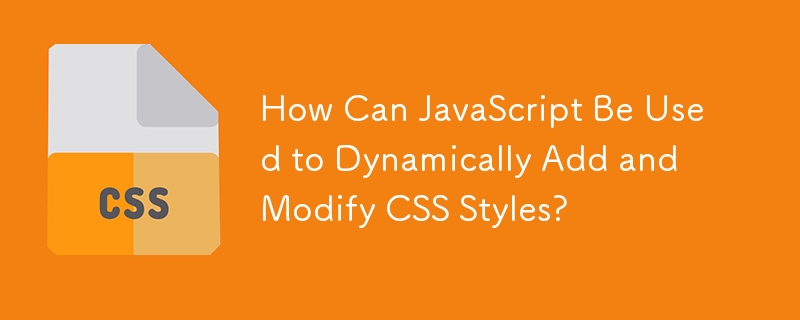Found a total of 10000 related content


Quick Tip: Add or Remove a CSS Class with Vanilla JavaScript
Article Introduction:Use JavaScript to dynamically add and delete CSS classes to easily manipulate web elements! This article will explain how to use JavaScript's className and classList attributes to efficiently manage CSS classes, and realize dynamic modification of web page elements, such as displaying/hiding menus, highlighting form errors or element animations.
Core points:
JavaScript can be used to dynamically modify page elements based on user interactions (such as showing/hiding menus, highlighting form errors, or animation effects).
className and classList properties are powerful tools for operating CSS classes; className has wider compatibility, while classList is more modern
2025-02-17
comment 0
454

Angular Interceptor
Article Introduction:Angular interceptor: two implementation methods and application scenarios
This article introduces Angular interceptors, including class -based interceptors (using withInterceptorsfromdi) and function -based interceptors (using withInterceptors), and explain its applications in modifying requests, processing response, global error processing, and request log records.
Core function:
Add authorized token: Add licensed token to the Security API.
Modify the request or response: Add head information and change data.
Automatic processing error: Display error information when request fails.
Request log record: track all HTTP requests for easy debugging.
Comparison of interceptor type:
base
2025-01-29
comment 0
403

Bootstrap Component Hacks: Customizing for Unique Designs
Article Introduction:Customized Bootstrap components can be customized to achieve personalized design. Methods include: 1. Add a new CSS class to override the default style; 2. Modify the source code or use JavaScript to dynamically change component behavior; 3. Use variables and mixin to optimize performance.
2025-04-06
comment 0
1129

How to create a custom Vue build?
Article Introduction:To create a custom Vue build version, first prepare the development environment, including installing Node.js, npm and cloning the official repository; secondly, modify the source code in the src directory according to the needs, such as deleting modules or adding instructions; then configure the build options in scripts/config.js, use Rollup to package and add terser compression and other plug-ins; finally execute npmrunbuild build and publish it to a private CDN or npmregistry. 1. Prepare the development environment: install Node.js and npm, clone the official Vue repository and install the dependencies. 2. Modify the source code: adjust the core logic, add and delete modules or add built-in instructions in the src directory. 3. Configure the build output: Edit c
2025-07-15
comment 0
167

How to change the output directory for Vue build?
Article Introduction:The method of modifying the construction output directory in the Vue project is as follows: 1. Modify the outputDir configuration item in vue.config.js and specify the relative or absolute path, such as module.exports={outputDir:'../my-output-folder'}; 2. Use environment variables to dynamically control the path, and define variables starting with VUE_APP_ in the .env file and read them in vue.config.js; 3. Dynamically generate configurations through Node.js scripts, which are suitable for automated processes. You need to modify the construction script in package.json and write the corresponding logic; you need to pay attention to path permissions, environment variable naming rules and V
2025-07-18
comment 0
814

how to set global variables in mysql
Article Introduction:Setting global variables in MySQL requires the SETGLOBAL command and persistence by modifying the configuration file. 1. Use SHOWGLOBALVARIABLES to view the current variable value, such as: SHOWGLOBALVARIABLESLIKE'max_connections'; 2. Use SETGLOBAL to modify the variable, such as: SETGLOBALmax_connections=500, note that some variables are string types need to be quoted, and some cannot be modified dynamically; 3. Modify the my.cnf or my.ini file and add configuration in the [mysqld] section, such as: max_connections=500, and re-
2025-07-17
comment 0
257

How to lazy load components in Vue?
Article Introduction:There are three ways to implement lazy loading of components in Vue projects: define asynchronous components using defineAsyncComponent, dynamically import components with routing, and add loading and error states. First, use the defineAsyncComponent method to combine dynamic import to achieve lazy loading of components; second, directly import components dynamically in VueRouter to achieve on-demand loading; third, add loadingComponent, errorComponent and delay to lazy loading components to improve user experience. These methods utilize Vue's asynchronous component mechanism and Webpack's code segmentation function to effectively reduce the loading time on the first screen and
2025-06-25
comment 0
764

Vue and Element-UI cascade drop-down box disable options
Article Introduction:The core point of disabling options for Vue and Element-UI cascade drop-down boxes: Use the disabled property of the options attribute to disable a single option. Dynamically generate options arrays based on backend data or user operations, including disable information. Avoid directly modifying options arrays, but create new arrays and copy modifications. Use computed properties to dynamically update options arrays to achieve responsive updates. Customize disable logic and optimize algorithms and readability.
2025-04-07
comment 0
723

How do I handle form submissions in Laravel?
Article Introduction:Five core steps are required to handle form submission in Laravel: first, define POST routes in web.php, such as Route::post('/submit-form',[FormController::class,'handleForm']) and ensure that the form contains @csrf; second, use Artisan to create a controller and define the handleForm method to receive the Request object to obtain the input value; third, use validate() method to verify the input data and display error information with Blade; fourth, if the file is uploaded, add enctype="multipart/form-dat
2025-06-21
comment 0
257

How to use -ldflags to embed version information in a golang binary
Article Introduction:In Go projects, you can inject version information into the binary file through the -ldflags parameter. 1. Use the -X flag to set string variables in the main package such as version and commit; 2. Dynamically obtain Git information in CI/CD and inject it; 3. You can add more metadata such as builtAt and isDirty; 4. Note that variables cannot be modified in the initialization block and the paths and quotes must be processed correctly.
2025-07-04
comment 0
367

How to manage multiple users in Chrome
Article Introduction:To add multiple users, click the avatar in the upper right corner to select "Add" or "Manage other users", add an account or create a guest account, and after setting it, you can use their respective bookmarks, history and extensions independently. Each user data is completely isolated, including passwords, plug-ins, automatic filling information, etc. To delete a user, go to Settings > Profile, select a user and click "Remove from this device", or you can also modify the user name and avatar for identification at any time.
2025-07-16
comment 0
125

How to use the fieldset and legend tags in an HTML form?
Article Introduction:and is used to organize relevant fields in HTML forms to improve accessibility and user experience. 1. Use a package to wrap a set of related form controls to implement logical grouping; 2. Add tags inside each to serve as the title of the group to provide context information for the screen reader; 3. Multiple different parts of a long form, such as personal information or payment methods; 4. Avoid using them in forms that contain only a small number of unrelated fields or a single input. Using these two tags reasonably can enhance the clarity and usability of the form structure.
2025-07-05
comment 0
833

How can JavaScript be used to create and manipulate HTML tags?
Article Introduction:JavaScript dynamically creates, modifys, moves and deletes HTML elements through DOM operations. 1. Use document.createElement() to create a new element and add it to the page through appendChild() or insertBefore(); 2. Select existing elements through querySelector() or getElementById(), and modify them using textContent, innerHTML, setAttribute() and other methods; 3. When processing multiple elements through loops, you need to note that querySelectorAll() returns NodeList; 4. Move
2025-07-01
comment 0
1051

How to create a form in HTML?
Article Introduction:To create an HTML form, you need to master the basic tags and structure. The specific steps are as follows: 1. Use the tag to wrap the content and set the action and method attributes; 2. Add input fields such as text, password, radio, checkbox, email and submit; 3. Use and implement the information of the tags to improve the interactive experience and add the name attribute to each input item; 4. Use and implement the drop-down menu and multi-line text input; 5. Pay attention to the settings of required items, the various implementation methods of the submission button, and the customization of form styles. Master these key points to quickly build a complete HTML form.
2025-07-05
comment 0
170

How do I use the readonly attribute to make an input field read-only?
Article Introduction:To make the input field read-only, use the readonly property. 1. Add readonly attribute to the input tag to achieve read-only effect; 2. readonly allows users to select and copy content and submit it with the form; 3. Unlike disabled, the latter is not submitted with the form and cannot gain focus; 4. The read-only state can be dynamically controlled through JavaScript, such as setting input.readOnly=true or false; 5. Pay attention to testing form submission behavior, accessibility and visual style when using it to improve user experience.
2025-06-22
comment 0
828

What is the HTML DOM (Document Object Model)
Article Introduction:DOM is a structured object model that the browser parses HTML files into. Through a tree structure, JavaScript can dynamically manipulate page content, structure and style. It corresponds to HTML tags in the form of nodes, such as element nodes and text nodes. JavaScript implements interactive operations through the API provided by DOM, such as: 1. Get elements (such as document.getElementById); 2. Modify content (such as textContent); 3. Add or delete nodes (such as createElement and appendChild); 4. Listen to events (such as clicks and inputs). The dynamic nature of DOM enables web pages to respond to user behavior in real time, and is the core of front-end development.
2025-07-07
comment 0
760

How to use push function for vue
Article Introduction:The push() function in Vue is used to add new elements to an array, modify the original array and return a new length. Usage method: Define the array, use the push() function to add elements, and the new element will be added to the end of the array. Example: const arr = ['a', 'b', 'c']; arr.push('d'); Returns the new array: ["a", "b", "c", "d"].
2025-04-08
comment 0
1171

What is the difference between slice() and splice() array methods?
Article Introduction:slice() will not modify the original array, return the copied part; splice() will modify the original array, which can be used to delete or add elements. The specific differences are as follows: 1.slice() is used to safely extract array fragments without changing the original array; 2.slice() is used to modify the original array, and can delete or add new elements; 3.slice() supports negative indexes, indicating the countdown from the end; 4.splice() also supports negative indexes; 5.slice() is suitable for scenarios where the original array needs to be kept unchanged; 6.splice() is suitable for situations where the array content needs to be dynamically adjusted.
2025-06-29
comment 0
317



















